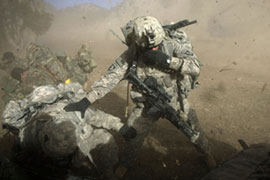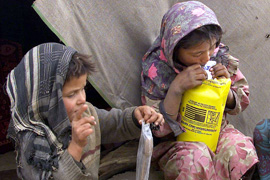Afghans rue Bush’s ‘war on terror’
How much have the lives of Afghans changed under Bush’s policies towards their country?

 |
| In his last visit to Afghanistan as president, George Bush said progress had been made [AFP] |
On the day George Bush, the US president, ends his period in office, millions of Afghans will be battling the bitter cold of winter and possible starvation.
Eight years after Bush launched his “war on terror” following the September 11 attacks, much of the human cost of it remains under-reported.
Increased fighting in the country has gradually decreased the ability of the UN, humanitarian agencies and NGOs to deliver basic services to the most vulnerable Afghans.
The UN now categorises 79 of the 364 districts of the country as areas of “extreme risk,” and international staff almost never travel by road.
The lack of access is likely to increase in the short term, further debilitating the delivery of basic services like food, health and education.
Not only is the country facing a worsening security situation, but even the best case scenario, which sees hope in the influx of additional troops next year, predicts increased fighting and greater violence in the short term.
Farewell visit
During his recent visit to Afghanistan, his last one scheduled before he leaves office, Bush spoke of the challenges ahead but said the situation had improved since the Taliban were removed from power by US forces in 2001.
 |
| US troops are coming under increasing pressure in Afghanistan [AFP] |
“You know, I was thinking … how much Afghanistan has changed since I have been the president.
“Sometimes its hard when you’re in the midst of a difficult situation, it’s hard to get perspective.
“In 2002 the Taliban were brutally repressing the people of this country. I remember the images of women being stoned, or people being executed in the soccer stadium because of their beliefs.
“There was a group of killers that were hiding here and training here and plotting here to kill citizens in my country.”
However, for many Afghans, 2001 no longer remains a valid comparison, as worsening security, disappointed hopes and increasing economic challenges erode the goodwill of the initial years of the government of Hamid Karzai, a government that Afghans say, was selected by the US.
‘No power’
Mariam is a middle-aged woman from a proud family in the northeastern province of Panjshir, the former stronghold of the legendary Ahmed Shah Massoud, the anti-Taliban commander.
|
“Isn’t Karzai an American installation? Najibullah worked to help Afghans. What is Karzai doing? I don’t see any hope in the future.” Mariam |
She is conservative enough to stay indoors when non-family male members are visiting, but also advocates family planning to her daughter-in-laws.
Mariam saw her family battle troops from the Soviet Union following their invasion in 1979.
“Then, during the Taliban, we took refuge in Panjshir. But during Najibullah’s [the Soviet-backed former Afghan leader] time we had power. Now there is none. I am ill but the doctor costs so much. During the Soviet time we had free medical care.
“Isn’t Karzai an American installation? Najibullah worked to help Afghans. What is Karzai doing? I don’t see any hope in the future.”
In decline
In a recent survey carried out by The Asia Foundation, a US-based non-governmental organisation (NGO), only 39 per cent of the population said they were more prosperous now than under the Taliban, while 36 per cent said they were less prosperous.
 |
| Many Afghans rely on foreign aid for basic foodstuffs [AP] |
Two years ago, those who felt more prosperous were nearly double those who felt less prosperous, indicating a trend of declining economic prosperity.
While Mariam is well-off by Afghan standards with several of her sons employed in urban jobs, the Afghan population at the bottom of the ladder faces severe hardship.
The percentage of the population below the minimum dietary level has increased from 30 to 35 per cent, according to the World Food Programme (WFP).
While there has been considerable focus on the need for more troops, the UN joint emergency appeal remains under-funded by 50 per cent, with donor commitments trickling in too slowly to make sure food stocks arrive before winter.
“Around 1.6 million children under five years and 625,000 women of child-bearing age are at risk of dying this winter due to malnutrition,” the ministry of public health said in a recent statement, adding that food shortages had been exacerbated by drought, high food prices and loss of livestock across the country.
Deliveries of emergency food stocks have also been hampered by insecurity, with WFP food convoys being attacked more than two dozen times this year.
The crisis has been in the making for several years.
Though 80 per cent of the Afghan population is dependent on agriculture for their livelihood, the sector has been severely under-funded, receiving only about $500m of the $15bn spent on development aid in the country since 2002.
USAID, the largest donor, has spent only five per cent of its budget on the sector in this period, according to Oxfam.
Education threatened
Initial gains in the health and education sectors were largely the result of NGOs who partnered with the donor agencies and the Afghan government.
Their decreasing access means “these gains are on the verge of being reversed”, says Mudasser Hussain Siddiqui, a policy advocacy and research manager for Action Aid, an international NGO.
 |
| Childbirth remains dangerous in Afghanistan [GALLO/GETTY] |
Siddiqui also points to increased threats to schools if they are used as voter registration areas or polling booths during the election year (presidential elections are expected in 2009), a step that would make them “more vulnerable to attacks since they would be perceived as legitimate targets” by Taliban-supporting fighters.
Between July 2007 and June 2008 there were 230 incidents affecting education, according to Unicef.
These included the burning down of schools, bombings, military operations in the vicinity and killings of teachers and students.
Jamshid Hashimi is from a traditional family in Logar province, adjoining Kabul.
“During the Taliban years, girls from my family attended the secret underground schools to get an education. After the departure of the Taliban, they attended the new overground schools.
“Even the young brides married into the family went to school to finish their interrupted studies. That is until last year, when they all stopped.”
“My sister-in-law was shot dead by insurgents as she walked to school,” says Jamshid recalling the day with a painful clarity that brought tears to his eyes.
“Now, we are too scared to send the girls to school, including my own wife. They have all stopped going.”
According to the ministry of education, attacks on schools and insecurity have forced 300,000 children to abandon their schooling.
Healthcare
|
“We know what to expect from the Taliban, but we don’t expect the same from the international forces. They are the ones upholding the rule of law and establishing democracy. They can’t be the ones killing innocents.” Mohammed |
Health facilities have also been forced to close as a result of attacks and threats.
Though government statistics boast that 80 per cent of Afghans receive healthcare, 36 health facilities in the southern and eastern provinces have been shut down.
As a result more than 360,000 people in the provinces of Helmund, Kandahar, Farah, Zabul and Paktika are deprived of health coverage.
Unicef says the insecurity is also hampering the polio eradication initiatives and efforts to expand the number of women health professionals in the country.
The result is one of the highest maternal mortality ratios anywhere in the world.
This year, 24,000 maternal deaths are expected in Afghanistan – several times the number of civilians who will die directly from the ongoing conflict.
Roots of anger
Most who have been affected by violence this year say the violence was not related to the insurgency.
According to the Asia Foundation survey, only eight per cent of those who had suffered violence attributed it to the Taliban.
However, civilian casualties as a result of military operations by international forces have been a lightening rod for public anger and Mohammed, a resident of Kabul, explains the roots of this anger and why deaths caused by the international forces stir more anger than those by the Taliban.
“We know what to expect from the Taliban, but we don’t expect the same from the international forces. They are the ones upholding the rule of law and establishing democracy. They can’t be the ones killing innocents,” he said.
This willingness to hold the international community to higher standards of accountability is seen as a positive sign and evidence that Afghans still have great hope for change.
However, by constantly comparing itself to the Taliban, as Bush did during his recent visit, the international community is, many say, putting this significant distinction at risk.